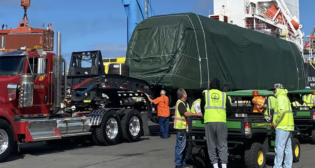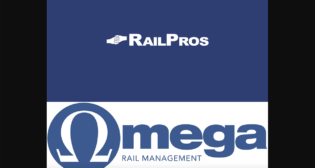
Rail renewal roundup
Written by Mischa Wanek-Libman, Editor, Railway Track & Structures; and Engineering Editor, Railway AgeMaking the rail renewal process safer and simpler is a top priority among equipment manufacturers and contractors.
Railroads spend billions each year on rail renewal, and the companies that help them perform the task are making it safer and simpler to accomplish. But simply replacing rail is not all that modern rail renewal and delivery machines do. Many come with value-added services that provide speed of delivery, ease of maintenance and other benefits.
Adaptable design
The Rail Renewal System (RRS) from Harsco Rail is used for rail renewal, pad replacement and rail seat abrasion repairs on concrete tie track. The company notes that since the system was developed, rail has become bigger, fasteners have changed, pads have improved and epoxies have advanced.
“The RRS has adapted to all of these changes and is currently being upgraded to apply a quick-setting epoxy cured by an ultraviolet light, as well as a more viscous epoxy used for rail seat abrasion repair,” says Harsco Rail.
The RRS is a high-production system capable of simultaneously replacing both rails at an average rate of 1/2 mph to minimize track possession time. “The system reduces cost per unit, reduces labor and enhances safety while providing high quality results. Other ‘efficiencies’ of the RRS include induction rail heating, bulk material handling, and scrap material collection,” says Harsco Rail. “One of the principal advantages of the RRS is that it takes everyone off the ground and into seats. At the same time, the old and new rails are all contained in rollers throughout the rail renewal process.”
Unloading safety
Herzog Railroad Services, Inc. (HRSI), provides a combination of equipment to help with rail handling. The company’s Rail Unloading Machine (R.U.M.) unloads at a rate of up to 10-12 rails per hour and operates with single- or dual-sided unloading options. Tim Francis, Vice President of Marketing, says safety and cost reduction benefits are associated with the R.U.M. He says employees and/or contractors are not in the “direct line of fire” when rail is unloaded, which makes for a safer unloading process. Additionally, he notes that there is no need for railroads to provide a winch car, which results in purchase and maintenance costs for that car being removed.
HRSI also offers the Automated Tie Down Car, which can be used separately or in tandem with the R.U.M. Francis says that when used with the R.U.M., only a pilot is needed, which reduces worker exposure and increases the safety factor of the unloading process.
The clamps on the Automated Tie Down Car are operated remotely, the only operation of this sort in a tie down car in the industry, notes Francis. When used with HRSI’s R.U.M., the clamps can be opened and closed remotely from inside the R.U.M. operator’s cab.
Francis says that standard manual unclamping of rails on average takes between 1.5 to 3 minutes per rail, but the Automated Tie Down Car unclamps a rail in six seconds, which results in significant productivity gains and allows for a reduction in track time required.
High production
Scott Diercks, Director of Marketing and Business Development at Loram Maintenance of Way, Inc., says that as railroads look to renew their fleets, they address concerns of antiquated equipment and seek to gain production efficiencies, as well as improve safety.
“Loram’s Raptor outperforms traditional rail-handling systems with double the production at 3,000 feet per hour, provides a better solution for the entire process of rail relay as opposed to a system focused solely on rail delivery, and diminishes risk of injury by reducing the human interaction and retaining total control of the rail while loading and unloading,” says Diercks.
Diercks notes that the life cycle of rail includes four primary logistical components: transport of rail from steel mill or ship to welding plant, delivery of CWR from plant to trackside, pick-up of relay rail for reuse or re-welding, and pick-up and disposition of scrap rail. He says the Raptor’s modular design can adapt to provide service in any of these four areas by incorporating design features that anticipate future expected changes of rail size and long-rail delivery needs.
“Raptor’s many strengths lie in its lower manpower requirements, vast improvements in safety vs. traditional units, productivity improvements, value-added rail quality improvements by eliminating torch cutting of ends and providing drilled bolt holes that will improve relay gang effectiveness, and a top load design that will prove critical as rail rolling and welding processes evolve,” says Diercks.
Product evolution
Bob Coakley, Nordco, Inc.’s Director of Sales and Marketing, says the company’s strategy is based on partnering with customers to exceed joint expectations for safe rail renewal that doesn’t impact train velocity.
“Over the past 10 years, we have seen our customers become more involved in product development, helping us focus on improving our equipment,” says Coakley. “Customers have done an extremely good job of studying pain points on their current rail renewal equipment and driving improvements back through our product improvement and manufacturing process. Nordco has continued to seek new and innovative solutions that drive increases in customer value through a rigorous focus on three key metrics— people, productivity, and customer profitability.”
“To understand our vision more clearly, we can look at the evolution of a few of our key products,” notes Coakley. “We have successfully rebuilt older-model Nordco Spikers into models with the productivity and reliability of the latest design at a fraction of the cost of a new one. We have led the industry in providing ergonomic solutions for the majority of our new machines, drawing on expertise in roadway work equipment design and manufacturing. A prime example is the Nordco BAAM – Anchor Applicator. The Nordco BAAM includes a number of new features including a fully enclosed operator cab equipped with air-conditioning, positive ventilation, comfortable controls, and a noise and dust free environment. This is a focus on keeping our customer’s personnel safe, comfortable and productive.”
Coakley says Nordco continues to work with its own suppliers to understand the latest in design for mobile equipment, noting that Nordco customers see increased reliability and/or easier maintenance of equipment from upgrades to hydraulic manifolds, bearings, or fittings.
Smooth operator
ROBEL’s Rail Train makes transport, loading and unloading of long welded rails safe, accurate and efficient, the company says.
ROBEL, a specialist for railway construction equipment and machinery located in Freilassing, Germany, supplies Rail Trains operated by four people and consisting of three components: the Rail Manipulator (RM) gantry for loading and unloading rails onto/from the transport unit running over the full length of the Rail Train; the two-sided Chute Wagon Set (CWS) guiding the rails during the loading/unloading process and placing the unloaded rails either alongside or between the tracks; and a Transport Wagon Set (TWS) carrying up to 50 rails on roller gates in up to five layers with a maximum length of 500 meters (approximately 1,640 feet).
For unloading, the ends of two rails are seized and pulled toward the CWS. The rails glide into the guide rollers of the CWS channels and are gripped again and pushed from the train until their ends smoothly touch the ground. The locomotive then pulls the train away while the RM moves with synchronic speed in the opposite direction. The rails slide down spring-loaded chutes mounted at the ends of the unloading channels. ROBEL notes that this technique avoids damage to the ties due to impact caused by the rails. When there is sufficient friction force on the track bed, the manipulator releases the rails and grips the next pair. ROBEL adds that “at no time are the bending and stress limits exceeded. The unloading time for two 180-meter (590.5-foot) rails is about two minutes, with loading taking no more than four minutes.”
The automated version of the Rail Train, ARTS (Automated Rail Train System), deployed since 2014 by Germany’s Deutsche Bahn, reduces manual operations to a minimum, resulting in higher safety and sustainable cost reduction, says ROBEL. Three people, who at no point of the process come in contact with the rails, operate the system. In Australia, an ARTS was deployed in January 2016, the first of its kind outside of Europe.



